TEMPORAL DISTRIBUTIONS OF VOLATILE ORGANIC COMPOUNDS (VOCs) IN AN EQUATORIAL URBAN ENVIRONMENT
by Wesam Al Madhoun
MIT-UTM Malaysia Sustainable Cities Program, UTM Johor Bahru, Malaysia
Department of Environmental Engineering, The Islamic University of Gaza, Gaza, Palestine
Abstract
Volatile Organic Compounds (VOCs) are emitted mainly from motorized vehicles. They are considered to be carcinogenic. This research aimed to investigate the correlation between traffic flow and VOC trends and concurrently to examine the impacts of the weather parameters. The concentrations of VOCs were monitored at urban site (near Chowrasta Market) in Penang in Peninsular Malaysia in 2010 and 2015. Traffic volumes were recorded simultaneously. The monitoring of VOCs was performed using the Photo Ionization Detector (PID).
The results showed that the mean concentration of VOCs during the morning rush hour was 436 ppb in 2010 and 631 ppb in 2015. The results of Pearson's correlation analysis showed a negative correlation (average r > -0.64) between VOCs concentration and temperature, while there was a positive correlation (average r > 0.78) with humidity. The traffic composition results show that more than 90 percent of the vehicles were cars and motorbikes. The United States Air Quality Standards stipulated that the ambient VOCs should not exceed 0.22 ppb. The results showed that the current concentrations of VOCs exceeded the permissible limits set by the US standards. These results indicate the need for regulating the VOCs emissions from motorized vehicles, due to the potential negative health impacts they pose to the public.
Introduction
Volatile Organic Compounds (VOCs) are emitted from various sources. They play a vital role in the tropospheric chemistry, but also pose health risks to human beings [1, 2]. Benzene, toluene, ethylbenzene, and xylenes (BTEX) are subgroups of VOCs, which are mainly emitted in automotive exhausts and evaporative emissions from plastics production, paints, glues, solvents, etc. For indoor environments, most BTEX emissions are related to indoor activities such as cooking, heating, smoking, and cleaning, as well as emissions from building materials, varnishes, paints and solvents [4, 5].
The International Agency for Research on Cancer (IARC) has classified benzene as a carcinogenic compound. It is emitted mainly from petrol-fueled cars, and thus is found in all urban areas [3, 6, 2]. Light-duty vehicles (LDVs) and heavy duty vehicles (HDVs) make different contributions to the overall volume of emissions. Aldehydes, BTEX, and alkanes are mainly produced by LDVs, while HDVs dominate the emissions of CO, NOx, SO2, and PM10 [7]. VOCs are also emitted in the interiors of motor vehicles, which comprise a wide variety of synthetic materials [8].
Exposure to benzene can lead to acute myeloid leukemia (AML), and can cause damage to specific components of human deoxyribonucleic acid (DNA) [9], resulting in chromosome rearrangements or loss [10, 11]. Although benzene concentrations are generally low in the ambient air, an increased risk of leukemia is associated with cumulative benzene exposures, as well as with benzene exposure intensities [12]. Studies by Savits [13] and Wolff [14] have also found an association between traffic density and the incidence of leukemia in children [15]. Accordingly, United States Air Quality Standards stipulate that the ambient VOCs should not exceed 0.22 parts per billion (ppb) [16].
The rapid growth of the Malaysian economy over the past 30 years—comprising the development of industrial estates, thermal power plants, and petroleum industry infrastructure—could result in the deterioration of the environment, if due care is not taken. These potential environmental challenges, particularly associated with air-quality degradation, may result from emissions from vehicles and industries, particulate matters from stacks and exhaust, dust from quarrying activities and construction projects, and open burning [17].
In several large cities, air pollutants are found to be increasing over time, and at times have exceeded the levels prescribed by the Malaysian national ambient air quality standards. This phenomenon can be seen from the monitoring and studies done on ambient air quality. Stated simply, there are three major sources of air pollution: mobile, stationary, and open burning. In Malaysia, the mobile sources contribute 82 percent of the pollution in the country [17]. This reflects the fact that there has been a steady increase in motor-vehicle ownership in Malaysia. In 2013, there were almost 23 million registered vehicles running on Malaysia’s roads [18]. In 2009, by contrast, there were just over 19 million registered vehicles in Malaysia.
The World Health Organization (WHO) estimates that a lifetime exposure of 0.17 g/m3 gives rise to an excess risk of developing leukemia at a rate of 1 per 1 million inhabitants, based on toxic-kinetic models [19]. In Sweden, a relationship between acute myeloid leukemia (AML) and car density has been established; the incidence of AML was 5.5 in regions that have more than 20 cars/km2. Even relatively low benzene concentrations in ambient air are likely to be dangerous; other studies have also found an association between traffic density and incidence of leukemia in children [15].
The main aim of this study is to bridge the gap of knowledge for the Malaysian scenario in term of understanding the dimension of VOCs from vehicular emissions at an urban site in Penang. This is important because of the negative health impacts that VOC emissions pose to public health.
Methodology
Study location
The monitoring of benzene was carried out at Chowrasta Market (CM) [Urban, 5°25'4"N 100°19'53"E]. The sampling location is shown in Figure 1.
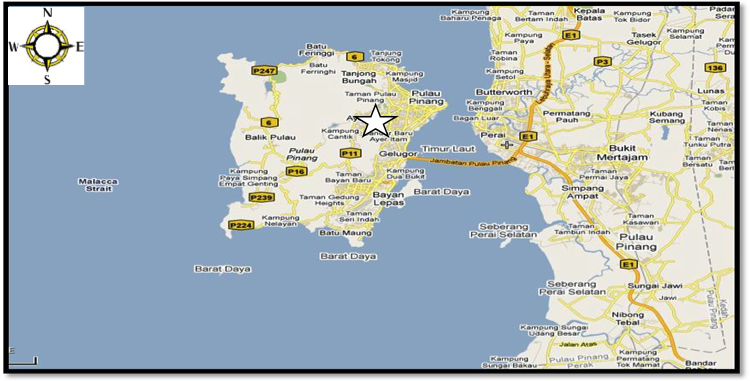
VOC measurements
The measurement of VOCs was carried out using Direct Sense Indoor Air Quality (IAQ) portable meter equipped with a Photo Ionization Detector (PID) sensor, which is capable of measuring TVOC, CO, CO2, temperature, and relative humidity simultaneously. The ranges of IAQ detection were from 20 to 20,000 ppb [19, 17]. The potential of PID lamp of the IAQ is 10.6 electron volt (eV), which means that it is capable of detecting benzene, which has ionization energy of 9.25 eV. [20]
The IAQ was used to measure VOC concentrations at an urban site near Chowrasta Market in the Penang area during morning, afternoon, and evening peak rush hours (over the course of two days: one in 2010, and another in 2015). Manual traffic counts carried out concurrently. Meteorological parameters (temperature and humidity) were also recorded, minute by minute, to study their influence on VOC concentration. The data were checked and found to be reliable. All vehicle types were converted to passenger car unit (PCU) to be a unified factor. Conversion was done based on the standard values where PCU = (car) + (0.33 * motorbike) + 1.75*(lorry) + 2.25*(truck) + 2.25*(bus). Correlation analysis was done among VOC concentrations, temperature and humidity, and carbon monoxide emissions to elucidate possible sources of VOC.
Results and discussion
Traffic characteristics
As noted, traffic flow was monitored at the site to record volumes during morning, afternoon, and evening rush hours. The traffic count was done continuously from 7:00 to 19:45, and the results are shown in Figure 2.
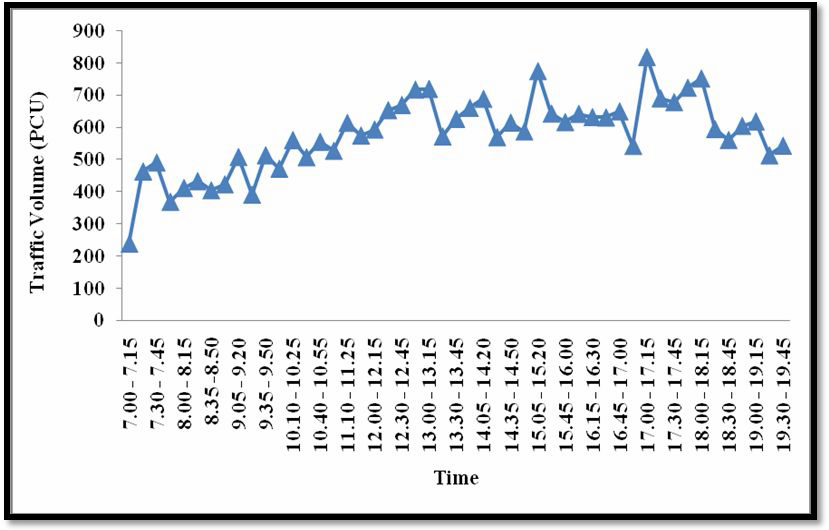
Peak traffic flows on Penang roads tend to fluctuate. The rush-hour peaks in the morning, afternoon, and evening were from 7:00 to 10:00, 12:00 to 13:30, and 17:00 and 18:30, respectively. As noted, two days of monitoring (one in 2010, another in 2015) were carried out to monitor VOCs levels at the site. Figures 3 and 4 show the traffic trends obtained at the CM site in both 2010 and 2015 respectively. They show that in the morning, the peak (in 2010) occurred in the second quarter (19.6 percent of the traffic) of the peak period, while in 2015, it occurred in the third quarter (19.06 percent of the traffic). In the evening, the peak was in the first quarter (20.5 percent of the 2010 traffic), while the 2015 peak came in the third quarter (19.1 percent of the traffic). This illustrates a consistent volume of traffic on the road on a daily basis.

VOC trends
Figures 5 and 6 present the trends of VOC concentrations and the ambient temperature during the three rush hours (morning, afternoon, and evening) in both 2010 and 2015. Note that there is an inverse relationship between VOC levels and temperature. An elevated concentration of VOCs was observed during low ambient temperature and vice versa. This is due to the reaction of VOCs with OH radicals, where OH radical reactions are dominant as part of the tropospheric removal process. One of the major sources of OH radicals is the photolysis of O3 in the presence of water vapor in the lower troposphere, where water vapor mixing ratios are high [21].
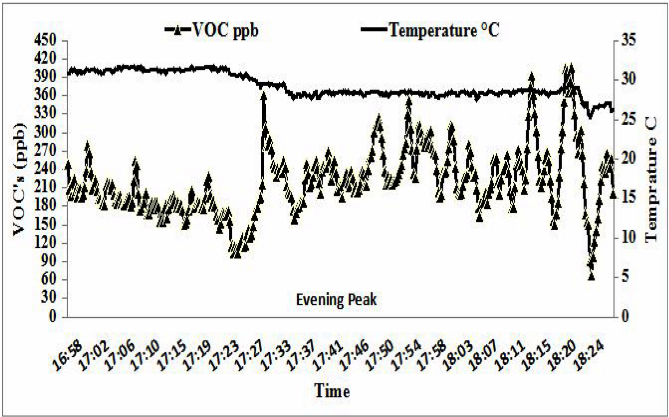

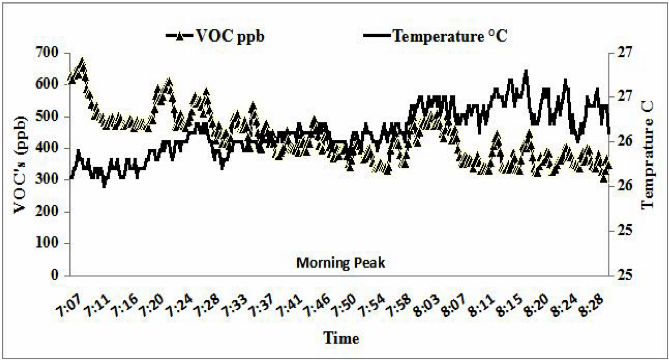
The results obtained in Table 1 showed that the 2010 average VOC concentration in the morning peak was 436 ppb, with a traffic volume of 2,359 passenger car units (PCUs) and a temperature of 26.10 °C. In 2015, the concentration was 631 ppb, with a traffic volume of 2,100 PCUs and a temperature of 26.8 °C. During afternoon peak, the VOC concentration in 2010 was 104 ppb, with a traffic volume of 4,144 and a temperature of 32.3 °C. In 2015, the concentration was 8.5 ppb, with a traffic volume of 3,693 PCUs and a temperature of 32.6 °C.

During the evening peak in 2010, the VOC concentration increased to 221 ppb, with a traffic volume of 4,119 PCU but with a lower temperature of 29.3°C. In 2015, by contrast, the VOCs levels jumped to 11 ppb with a traffic volume of 4,294 PCU and 31.7 °C temperature. Note that the highest VOC concentrations came during the morning peak, even though even the lowest peak volume occurs at that time. Thus, ambient air temperature does play a role in influencing the volatility of VOCs in the atmosphere.
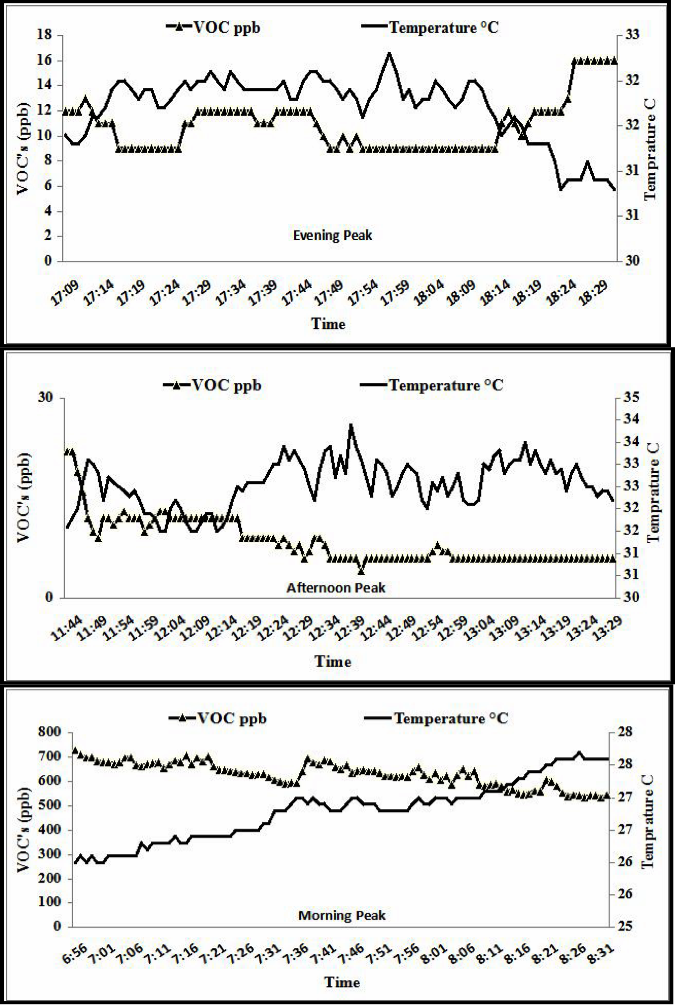
The drop in VOC concentrations shown in Figures 5 and 6 ranges from 76-98 percent in the afternoon, with an increase in temperature ranging from 18-19 percent. In the morning peak, VOCs levels were reduced by 25-44 percent while the temperature change was 2-6 percent. Variance of VOC concentrations during the three peaks, in other words, is due to changes in temperature, which then lead to the formation of OH radicals during high temperatures, when OH radicals react with the VOCs as part of the dominant removal process [22].
The VOC concentrations in Figures 7-8 and Table 1 show that the level at CM in the morning peak is higher even though the traffic volume is low; this is a result of both low temperatures and the “street canyon” effect, where the street is flanked by buildings on both sides creating a canyon-like environment.
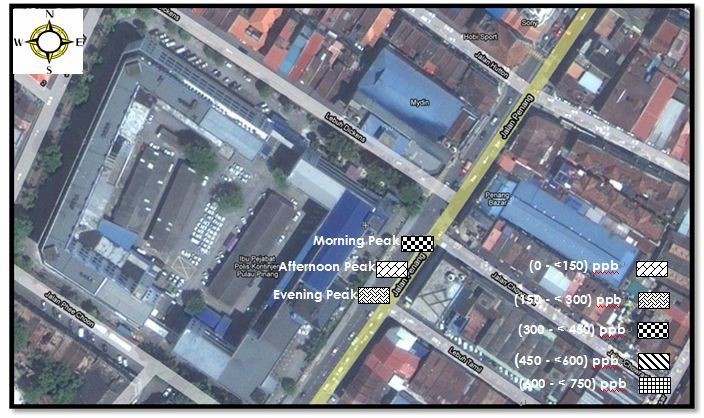
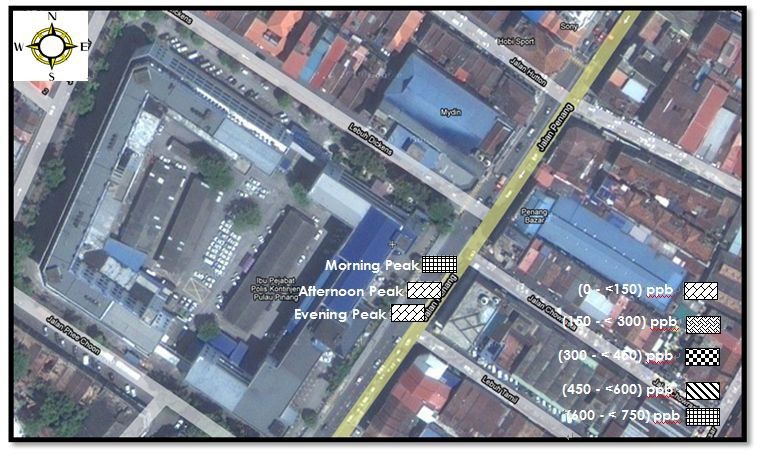
Weather influence
Table 2 shows that there is a negative correlation between the VOCs concentrations and temperature in both 2010 and 2015, where the average Pearson coefficient is -0.64. Meanwhile, it is clear that the correlation with humidity is positive, with an average Pearson coefficient of 0.78.
Policy implications
Penang has implemented the following traffic plans: directed traffic flow in one or two lanes, based on intensity, to reduce congestion on busy streets; improved traffic management control through adjusting the timing of traffic signals and by constructing roundabouts to reduce congestion; and provided free shuttle buses from the mainland to the island. (These buses are meant to transport both civil servants working at the island government compound and executives working at the Bayan Lepas Industrial Area.) In addition, the government of Penang has created a dedicated bike lane for certain areas of Georgetown, the main city on Penang island; increased enforcement of emissions standard inspection, both during car registration and changing of car ownership; and introduced car-free day in certain parts of Georgetown.
These strategies have reduced emissions levels and consequently improved air quality in the state. The state also plans to reduce private vehicle ownership by providing affordable and efficient public transportation.
Penang decision-makers might adopt the kinds of sustainable transportation policies that have been implemented by five major Asian cities: Hong Kong, Tokyo, Singapore, Seoul, and Shanghai. These include promoting public transportation, integrating land-use and transport planning, and instituting travel demand management. Even more stringent car-emission inspections, and an expansion of the car-free day program, could further reduce traffic emissions.
Conclusion
Based on the research described above, the following conclusions can be drawn:
- VOC concentrations were lower in the afternoon peak even though the traffic volume was greater than in the morning; this reduction in the concentration is due to the formation of OH radicals during high temperatures in the afternoon, where it plays a vital role in atmospheric degradation process of VOCs.
- VOC behavior with temperature changes shows that the concentrations dropped during morning peaks by 25−44 percent while temperature increased by 2−6 percent. In the afternoon peaks, the VOC concentrations decreased drastically—by 76−98 percent—due to the increase of temperature by 18−19 percent. During evening peak, VOCs concentration increased by 23−53 percent, while temperature decreased by 2.7−9.3 percent.
- Traffic composition shows that the main contributors (more than 90 percent) to traffic flow were cars and motorbikes, which not surprisingly were also major emitters of VOCs as well.
- Our Pearson’s correlation analysis shows a negative correlation (average r > -0.64) between VOC concentrations and temperature, but a strong positive correlation with humidity (average r > 0.78), which is explained by the physical processes involved in the degradation of VOCs.
- When comparing the VOCs concentrations in 2010 and 2015, note that the levels in the morning peak are still high, while there is a marked drop in the afternoon and evening peaks.
Based on this research, we urge authorities to implement more measures to reduces traffic emission, such as promoting the use of green engines (e.g. bio-diesel); tightening vehicle-emission standards and imposing tougher inspection standards on old vehicles (which emit more pollutants because of incomplete combustion); and promoting the use of public transport, which will reduce the percentage of cars and motorbikes in congested areas.
Transport planning and implementation in Penang still faces several challenges that need to be handled wisely in order to be more sustainable. At the same time, the positive results that have accrued from the strategies that Penang has already implemented serve as a promising example for less-developed cities.
Acknowledgements
The first author, Wesam wishes to thank Universiti Teknologi Malaysia for financial support given under the MIT-UTM Malaysia Sustainable Cities Program. The authors would like to express their sincere appreciation to the Universiti Sains Malaysia for the financial support under the scheme of USM Fellowship and the Research University Grant (1001.PAWAM.811066).
References
[1] Pilidisa, G. A., Karakitsiosa, S. P. Kassomenos, P. A. 2005. BTX measurements in a medium-sized European city. Atmospheric Environment. 39:6051–6065.
[2] Khoder, M. I., 2007. Ambient levels of volatile organic compounds in the atmosphere of greater Cairo. Atmospheric Environment. 41:554-566.
[3] Skov, H., Hansen, A. B., Lorenzen, G., Andersen, H. V., Lofstrom, P. Christensen, C., S. 2001. Benzene exposure and the effect of traffic pollution in Copenhagen, Denmark. Atmospheric Environment. 35: 2463-2471.
[4] Allou, L., Marchand, C., Mirabel, P., Calve, S. L., 2008. Aldehydes and BTEX Measurements and Exposures in University Libraries in Strasbourg (France). Indoor and Built Environment.17:138–145.
[5] Schneider, P., Lorinci, G., Gebefugi, I. L., Heinrich, J., Kettrup, A., Wichmann, H. E., 1999.Vertical and horizontal variability of volatile organic compounds in homes in Eastern Germany. Journal of Exposure Analysis and Environmental Epidemiology. 9: 282-292.
[6] Kerbachia, R., Boughedaouib, M., Bounouac, L., Keddam, M., 2006. Ambient air pollution by aromatic hydrocarbons in Algiers. Atmospheric Environment. 40: 3995–4003.
[7] Schmid, H., Pucher, E., Ellinger, R., Biebl, P., Puxbaum, H., 2001. Decadal reductions of traffic emissions on a transit route in Austria-results of the Tauerntunnel experiment 1997. Atmospheric Environment, 35: 3585-3593.
[8] Buters, J. T., M. Schober, W., Gutermuth, J., Jakob, T., Aguilar-Pimentel, A., Huss-Marp, J., Traidl-Hoffmann, C. Mair, S. Mayer. F. Breuer, K. Behrend, H. 2007. Toxicity of Parked Motor Vehicle Indoor Air. Environmental Science. Technology, 41 (7): 2622–2629.
[9] Bono, R., Degan, R., Pazzi, M., Romanazzi, V., Rovere. R., 2010. Benzene and formaldehyde in air of two winter Olympic venues of “Torino 2006.” Environment International. 36 (3):269-275.
[10] Escobar, P., A. Smith, M. T., Vasishta, A., Hubbard, A. E., Zhang, L., 2007. Leukaemia-specific chromosome damage detected by comet with fluorescence in situ hybridization (comet-FISH). Mutagenesis,22 (5): 321-327.
[11] Marcon, F., Zijno, A., Crebelli, R., Carere, A.,Veidebaum, T., Peltonenc, K,. Parks, R., Schuler, M., Eastmond, D., 1999. Chromosome damage and aneuploidy detected by interphase multicolour FISH in benzene-exposed shale oil workers. Mutation Research/Genetic Toxicology and Environmental Mutagenesis. 445 (2):155-166.
[12] Glass, D. C., Gray, C. N., Jolley, D. J., Gibbons, C., Sim, M. R., Fritschi, L., Adams, G. G., Bisby, J.A., Manuell, R. 2003. Leukemia risk associated with low-level benzene exposure. Epidemiology. 14(5):569-77.
[13] Savitz, D., Feingold, L., 1989. Association of childhood cancer with residential traffic density. Scandinavian Journal of Work Environment and Health. 15: 360–363.
[14] Wolff, S.P., 1994. Does environmental benzene exposure cause childhood leukemia? In: Leslie, G. and Perry, R., Editors, 1994. Volatile organic compounds in the environment, Indoor Air International. London : 491–501.
[15] Rommelt, H., Pfaller, A., Fruhmann, G. Nowak, D., 1999. Benzene exposures caused by traffic in Munich public transportation systems between 1993 and 1997. The Science of the Total Environment. 241: 197-203.
[16] Green Gurad website,US, (accessed on 13/12/2015) http://greenguard.org/Certificates/9687_cs.pdf
[17] Al Madhoun, W. A., Ramli, N. A., Yahaya, A. S., Yusof, N. F., Ghazali, N. A., Sansuddin, N., 2011. Levels of benzene concentrations emitted from motor vehicles in various sites in Nibong Tebal, Malaysia. Air Quality, Atmosphere and Health, 4(2): 103-109.
[18] Al Madhoun, W. A., Ramli, N. A., Yahaya, A. S., Rashid, M., 2015. Temporal Distribution of Non Methane Hydrocarbon (NMHC) in A Developing Equatorial Island. Air Quality, Atmosphere and Health. 1-8.
[19] Al Madhoun, W. A., Ramli, N. A., Yahaya, A. S., Yusof, N. F., Ghazali, N. A., Sansuddin, N., 2008. A Framework for Monitoring and Modelling of BTEX in Various Development Statuses in Penang, Malaysia. Proceeding of The International Conference on Environment 2008 (ICENV08) in Penang, Malaysia.
[20] Allgood, C., Chung, M. Y., Mumon, B., 1991. Quantitation Using Benzene in Gas Chromatography/Chemical Ionization Mass Spectrometry. Analytical Chemistry, 63: 721-725.
[21] Atkinson, R., (2000) Atmospheric chemistry of VOCs and NOx. Atmospheric Environment, 34: 2063-2101.
[22] Sarwara, G., Corsi, R., Kimuraa, Y., Allena, D., Weschler, C., J., 2002. Hydroxyl radicals in indoor environments. Atmospheric Environment, 36 (24): 3973-3988.
Notes
http://www.motortrader.com.my/news/21-25-million-vehicles-on-malaysian-r...

